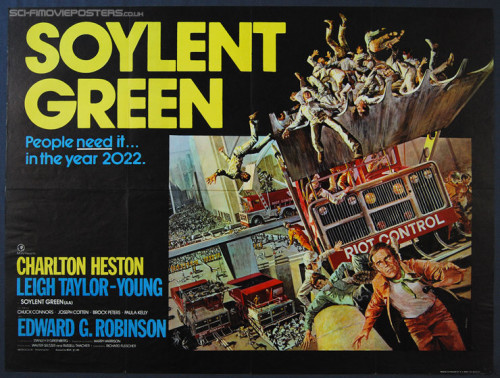Soylent Green is one of the most well-known eco-horror films to arrive in the last decade, garnering a small, but devoted, fanbase thanks to its strong performances and veiled environmental messages. At this point, even those who haven’t seen the movie are aware of the twist that is the real ingredient of the green soylent product.
Indeed, even if it weren’t already common knowledge that “soylent green is people,” the circumstances described early in the film lead to suspicion that all can’t be as it seems with the supposedly vegetable protein based soylent blocks. The setting is New York City in the year 2022, after the greenhouse effect has supposedly decimated plant and animal life all over the planet, making it highly unlikely that there would be sufficient vegetable or plankton growth to sustain the supply of soylent blocks of any color.
The film was released in theaters in 1973 following the formation of the Environmental Protection Agency and the creation of Earth Day a few years earlier. Based on the novel Make Room! Make Room! by author Harry Harrison, Soylent Green takes the consequences of overpopulating our planet to more thrilling and sinister conclusions.
On the surface, the movie seems just another futuristic action/crime thriller story, telling of the investigation into the murder of a wealthy lawyer and businessman, an investigation assigned to the overworked and underpaid Detective Thorn, portrayed by Charlton Heston. When he finds that the murder victim was on the board of directors at the immensely powerful and ubiquitous Soylent Corporation, the investigation takes a turn toward the inner workings of the company and lands Heston’s character in the crosshairs of the powers that be in both politics and the private corporate sector.
Going beyond the surface story, the message of environmental disaster brought about by a combination of human factors is as relevant today as it was when this film was first released. The idea of large corporations going to whatever lengths are necessary to protect their profits is as much in the forefront of today’s politics and general public opinion as it’s ever been, as are the various consequences of overpopulation on our planet’s resources.
According to the scientists at NASA, among others, the amount of carbon dioxide in our atmosphere has increased by about a third of the total just since the Industrial Revolution, due at least in part to our burning of fossil fuels for energy. The increase in carbon dioxide in our planet’s atmosphere is directly related to the increased greenhouse effect and overall rising temperatures – a condition that Soylent Green exploits as the reason for the food shortages that lead to turning recently deceased humans into food for the still living.
While it doesn’t seem likely that the world as we know it will become the world of Soylent Green by 2022, a mere six years away, it’s not so farfetched to believe that we could get there at some point in the not-so-distant future. This is particularly true if we don’t find ways to slow and possibly reverse at least some of the damage that’s been done to our planetary ecosystem in the name of progress and profit.
Just as in any smaller ecosystem that becomes unbalanced in some way, we could be leading to our inevitable extinction otherwise. After all, a population willing to cannibalize itself with those who die willingly is only one step away from killing each other for food when the need becomes great enough. I for one hope I’m not around to see that phase of “humanity.”
Written by Maria Rosita
Maria is a writer interested in comic books, cycling, and horror films. Her hobbies include cooking, doodling, and finding local shops around the city. She currently lives in Chicago with her two pet turtles, Franklin and Roy.





This page certainly has all of the info I needed concerning this subject and didn’t know who to ask. |